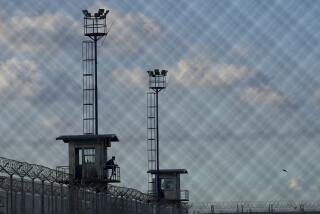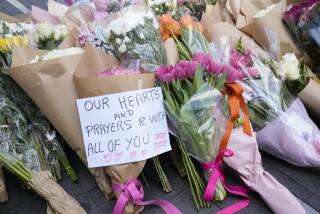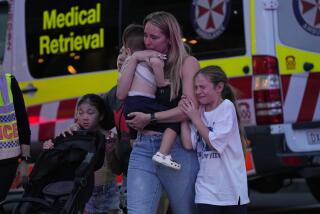Australia Urban Crime Turns Even More Brutal
SYDNEY, Australia — A man murders his 7-year-old stepson by shooting him through the eye at point-blank range.
A street gang throws a man off a moving train.
Three young men are sentenced to life in prison, never to be released, for the rape and murder of a young bank clerk.
These are just a few of the stories headlined in Sydney newspapers recently.
Police, social workers and judges say crime in Sydney, already Australia’s most violent city, is becoming more brutal.
“Crime statistics will show the rate of crime in Sydney is probably decreasing slightly, but the viciousness of crime has increased dramatically,” said Tony Day, president of the New South Wales Police Assn.
“Violence is much more rampant today compared with two years ago. There’s a hell of a lot more police being injured on a daily basis.”
For a city of 4 million people Sydney’s crime rate is average, said Don Weatherburn, director of the New South Wales Bureau of Crime Statistics.
In the year to June 30, 1989, the latest crime statistics show that there were 136 abductions, 57 murders, 3,200 sexual offenses and 2,567 aggravated assaults in Australia’s largest city.
“We are below American and South American cities and above northern European and Japanese cities,” said Weatherburn.
But criminologists say it is not the crime rate that is of concern so much as the increasingly violent nature of the crimes.
In September two bodies weighted down with garden rocks were found in the Parramatta River, which sweeps through Sydney’s sprawling western suburbs.
A history of gangland killings shows that Sydney has always been a violent city, said Paul Wilson, director of the Institute of Criminology in Canberra.
“But there’s a harder edge on the crime now,” said Wilson. “Attacks are more vicious than 10 years ago.
“As the city gets bigger, and there’s an increasing gap between the haves and have-nots, there’s more senseless violence.”
Wilson said a generation of street people who believe they do not belong in society has emerged as a result of the deteriorating economy and an increase in family break-ups and drug use.
“This subgroup of people are an underclass who believe they have no future in Australia,” he said.
“They have no chance of achieving the Australian dream of a house, a car and a place in the sun. They are prepared to live on the street and take what they need.”
On Sept. 8, 1988, three young members of this “underclass,” who had met only that morning, abducted bank clerk Janine Balding, 20, at knife-point from a train station parking lot in Sydney’s south as she was going home from work.
The gang drove her to an isolated dam in Sydney’s west, where they raped, bound and gagged her, dragged her over a barbed wire fence and later drowned her.
In ordering that the three never be released from prison, Supreme Court judge Peter Newman said recently: “This must be one of the most barbaric murders ever committed in the sad criminal history of this state.”
He said the three came from a “background where human values were degraded . . . and one which leads inevitably to serious criminal activity, often involving violence.”
Homeless men in the inner city are now afraid to spend the night on the street for fear that they will be murdered by street gangs looking for kicks, said Peter Higham, manager of the inner city’s Matthew Talbot hostel, which cares for 350 homeless men a night.
“I have been here for six years and there has been an increase in the number of attacks and the viciousness. They are now killing them (homeless men), not just rolling (robbing) them.
“A lot of the kids are bored and instead of looking for a job prefer to roll someone and live on the street.”
But it is not just the old who are falling victim to the violence.
Jason van der Baan, 20, had his face and hands slashed by a gang before being hurled from a train earlier this fall.
“I was grabbed from behind. The leader said: ‘Oh, the Aussie pig’s squealing. You’re gone. You’re out the door,’ ” he said.
When Van der Baan regain consciousness, he found that he was bleeding badly and had narrowly missed a railroad stanchion. After stumbling to a nearby hospital, he received 66 stitches, but has lost partial use of his left hand.
Weatherburn said rapidly expanding cities, such as Sydney, normally have high murder and assault rates.
“In cities that aren’t expanding, the level of social bonding between people is high and the level of social friction is low,” he said.
More to Read
Sign up for Essential California
The most important California stories and recommendations in your inbox every morning.
You may occasionally receive promotional content from the Los Angeles Times.










